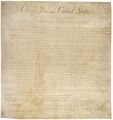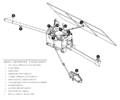Template:Selected anniversaries/September 25: Difference between revisions
No edit summary |
No edit summary |
||
| Line 27: | Line 27: | ||
||1906: In the presence of the king and before a great crowd, Leonardo Torres y Quevedo successfully demonstrates the invention of the Telekino in the port of Bilbao, guiding a boat from the shore, in what is considered the birth of the remote control. | ||1906: In the presence of the king and before a great crowd, Leonardo Torres y Quevedo successfully demonstrates the invention of the Telekino in the port of Bilbao, guiding a boat from the shore, in what is considered the birth of the remote control. | ||
||1911: Alexey Andreevich Lyapunov born ... mathematician and an early pioneer of computer science. Pic search | ||1911: Alexey Andreevich Lyapunov born ... mathematician and an early pioneer of computer science. Pic search. | ||
||1915: Ethel Rosenberg born ... American spy. | ||1915: Ethel Rosenberg born ... American spy. | ||
| Line 35: | Line 35: | ||
||1922: Johannes Petrus Kuenen dies ... physicist. He discovered retrograde condensation and published his findings in 1892 in the Ph.D. thesis with the title "Metingen betreffende het oppervlak van Van der Waals voor mengsels van koolzuur en chloormethyl". (Measurements on the Van der Waals surface for mixtures of carbonic acid and methyl chloride). He performed early experiments with x-rays with the physiologist Edward Waymouth Reid. Pic. | ||1922: Johannes Petrus Kuenen dies ... physicist. He discovered retrograde condensation and published his findings in 1892 in the Ph.D. thesis with the title "Metingen betreffende het oppervlak van Van der Waals voor mengsels van koolzuur en chloormethyl". (Measurements on the Van der Waals surface for mixtures of carbonic acid and methyl chloride). He performed early experiments with x-rays with the physiologist Edward Waymouth Reid. Pic. | ||
||1926: Stafford Beer born ... theorist, consultant and professor at the Manchester Business School. He is best known for his work in the fields of operational research and management cybernetics. Pic search | ||1926: Stafford Beer born ... theorist, consultant and professor at the Manchester Business School. He is best known for his work in the fields of operational research and management cybernetics. Pic search. | ||
||1928: Richard F. Outcault dies ... cartoonist, created ''The Yellow Kid'' and ''Buster Brown''. Pic. | ||1928: Richard F. Outcault dies ... cartoonist, created ''The Yellow Kid'' and ''Buster Brown''. Pic. | ||
| Line 42: | Line 42: | ||
||1933: Paul Ehrenfest born ... theoretical physicist, who made major contributions to the field of statistical mechanics and its relations with quantum mechanics, including the theory of phase transition and the Ehrenfest theorem. Pic. | ||1933: Paul Ehrenfest born ... theoretical physicist, who made major contributions to the field of statistical mechanics and its relations with quantum mechanics, including the theory of phase transition and the Ehrenfest theorem. Pic. | ||
||1942: Camp Shanks: Over 300 Orangeburg residents met at the Orangeburg School (now the city library) to learn that their homes, lots, and farms (amounting to approximately 2,040 acres (8.3 km2) west of the museum) were being seized for the immediate construction of a military camp. One hundred thirty families lost their homes. | |||
||1935: Adrien Douady born ... mathematician. Pic. | ||1935: Adrien Douady born ... mathematician. Pic. | ||
Revision as of 06:17, 13 December 2020
1644: Astronomer and instrument maker Ole Rømer born. He will make the first quantitative measurements of the speed of light.
1777: Polymath Johann Heinrich Lambert dies. He made important contributions to mathematics, physics (particularly optics), philosophy, astronomy, and map projections.
1789: The United States Congress passes twelve amendments to the United States Constitution: The Congressional Apportionment Amendment (which was never ratified), the Congressional Compensation Amendment, and the ten that are known as the Bill of Rights.
1819: Mathematician and Anglican theologian George Salmon born. He will work in algebraic geometry for two decades, then devote the last forty years of his life to theology.
1845: Judge Havelock With Glass is "a reasonably accurate depiction of events as I experienced them," according to the Judge.
1893: Mathematician and statistician Harald Cramér born. He will help found probability theory as a branch of mathematics, writing in 1926: "The probability concept should be introduced by a purely mathematical definition, from which its fundamental properties and the classical theorems are deduced by purely mathematical operations."
1992: NASA launches the Mars Observer, a $511 million probe to Mars, in the first U.S. mission to the planet in 17 years. The probe will fail eleven months later.
2002: Steganographic analysis of Humpty Dumpty At Bat reveals previously unknown biography of Babe Ruth by Lewis Carroll.
2003: Journalist, writer, literary editor, and actor George Plimpton dies. Plimpton is famous for his "participatory journalism": competing in professional sporting events, playing with the New York Philharmonic Orchestra, performing a circus trapeze act, and then recording the experience from the point of view of an amateur.
2018: Chromatographic analysis of Yellow Spiral unexpectedly reveals "at least five new shades of the color yellow, perhaps as many as nine."
2017: Dennis Paulson of Mars says that the twenty-fifth anniversary of the launch of the Mars Observer is a bittersweet event, because the spacecraft will be lost eleven months later.










